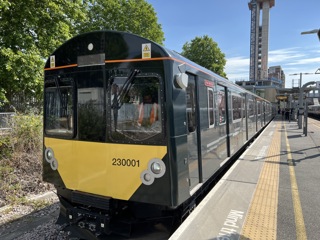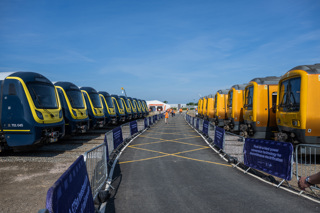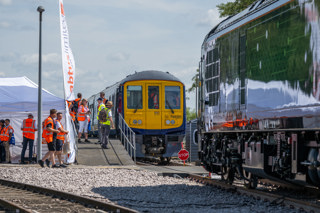Two years after the first lockdown, the economy has recovered to pre-pandemic levels. Yet we are still travelling less than we did before COVID.
A new study finds that the link between economic growth and increasing travel by private car has finally been broken. We are travelling less, but still achieving our economic and lifestyle goals. Less is more. That is new… and it ties in with the urgent need to decarbonise.
That has substantial and long-term implications for the way we provide public transport. Is subsidising reduced rail commuting bringing any real ‘levelling up’ or socio-economic benefit, as it used to be called? Do taxpayers really need to support faster journey times, more frequent services, or additional seats for people travelling on business?
Facing a sceptical Treasury, the rail industry needs to come up with convincing answers.
“It is not exaggeration to say that the coming months are critical for the long-term future of public transport,” concludes the Less is More study by respected academics at the Universities of Leeds and Stirling.
“We have been able to adapt significant elements of our daily travel to do what we want by travelling less,” they say.
“Governments have channelled huge amounts of subsidy into public transport during the pandemic. But the message is now coming through loud and clear that the purse strings are being tightened, and it is ‘last orders’ for additional revenue support.
“To meet our climate obligations, it is clear that we will need to travel less by car. As we come out of the pandemic, there is a chance to plan differently for transport, to encourage fewer trips.”
Jillian Anable, Professor of Transport and Energy at the University of Leeds, states: “Car use is not ubiquitous. One in four households does not have a car. But those households which do have a car use it for the majority of journeys. Whereas below 10% of the population use rail on any kind of regular basis. So, train users are a very select part of the population.
“Train use was disproportionately affected by COVID because of the proportion of passengers whose jobs are conducive to working from home. It’s no great surprise just how much more the railway was impacted.
“Most travel is not work-related. With car use, more than 50% of mileage is for leisure. Leisure travel bounced back, way before work travel. Leisure travel is an important part of the economy. But it is also an important part of wellbeing.
“We are in such a critical period for transport policy. As yet, there is no focus on this.”
Using new research across ten UK locations, the Less is More authors find that even if those people who worked from home go back to travelling for half their working week, car commuting will still reduce by 16%. Weekday car traffic has stabilised at around 10% below pre-pandemic levels.
The study authors call on government to commit to new incentives to lock in this lower travel, ensuring that large elements of commuting are replaced by digital connectivity as ‘business as usual’.
“If we could switch away from where the only view of development is ‘more growth means more traffic’ to one where we do not have to travel so far or so often, but can still do the things we want to, then we may have learned some of the transport resilience lessons from the pandemic,” they say.
How would that be manifested? The study does not mention major projects individually.
But: “We should ask ourselves whether the fetish for long-term investments which deliver comparatively small journey time benefits for commuters and business travellers needs re-evaluating. We have demonstrated that parts of the economy can work quite differently without relying on this.
“The pandemic has changed labour markets in ways and at a scale and pace which dwarfs transport infrastructure plans.”
Professor Anable: “COVID has turbocharged this change, accelerating the degree to which the economy and travelling have decoupled. Some of this is related to digital accessing of goods and services. We know that people were spending more on groceries during the pandemic, because they were at home more.
“Less travel happened. But expenditure did not fall. The headline story is that travel has reduced… and the economy has not.”
Professor Iain Docherty, Dean of the Institute of Advanced Studies at the University of Stirling, contends: “Rail is the most exposed travel sector. It is very dependent on occupation type. We know that rail users are wealthier, more middle class, more white collar than other transport users, and by quite some margin more than bus passengers. Buses did better during the pandemic because their passengers had to keep travelling to their fixed places of work - be that a hospital, a supermarket or factory.
“If you work in a white collar office job, you are not travelling as much to that office now. It means rail finances are very difficult.”
Anthony Smith, chief executive of Transport Focus, says it’s “quite hard” to argue with the central thesis.
“Car parks are not as full as they were - especially at stations. But rail has a big part to play in levelling up. Because rail carries a particular demographic now does not mean that’s the way it should be in the future. It is not a point to give up.
“Rail still does two things well. It carries large numbers of people relatively short distances commuting. And it carries smaller numbers of people very fast on longer distances.
“The value for money arguments around rail need to be addressed, to allow more people to access it. It is that simple. We reached ‘peak price’ on rail a long time ago. What has broken is rail’s ability to pass on its own inefficiencies through price rises. That has gone. If you put up prices any further, it will put many people off and entrench the perception that only people with money can get on the train.”
FEWER TRAINS, FEWER BUSES
In November 2021 (before the Omicron wave), rail was averaging 71% of pre-pandemic weekday patronage. Bus use was running at 81%. Car use has currently settled at 85%.
The Less is More study breaks down that pattern. For both bus and train travel, the reductions in usage were greatest among females, older people, the most highly educated, higher social grades, and those with children and cars.
Although the reductions in train travel are greater than on the buses, those on rail have been concentrated among a narrower subset of passengers: females and those with the lowest and highest education.
The study points out that this provides an opportunity to target specific segments of the population in campaigns, to attract people back.
But not the more general half-price off-peak campaign outside school holidays launched after Easter by Secretary of State for Transport Grant Shapps.
The report warns: “There is likely to be less commuting and much more variable patterns of commuting, all of which needs proactively managing. Lower public transport use can also bring about bad outcomes where service withdrawals make the service less attractive to the remaining users, who then look for other options.”
“There are two hits to the traditional rail market: city centre commuting to offices and city centre retail, both partly replaced by doing it from home,” says Stephen Joseph, formerly head of the Campaign for Better Transport and now a transport policy consultant and visiting Professor at the University of Hertfordshire.
“I just don’t think rail passenger numbers will come back fully, and the study is the first time we have reliable numbers to support this. Paradoxically, there will be more demand for late-night trains, because more leisure travellers will want to come home after an evening out.”
Professor Docherty says: “It shows the fragility of why we have been spending all this money on rail. It was being justified by the belief that magical agglomeration impacts occur - cramming more people into city centres, particularly London. It was used to justify lots more spending on increasing peak capacity.
“That concept is in some difficulty, given what we now know about people’s productivity working from home and using digital tools.
“But when you cut services, you make the overall product less attractive. Once you lose passengers, it is really hard to get them back. There’s a constituency of what used to be very regular commuters who are now just occasional commuters, who could shift to road. If they only go to the office once or twice a week, are they really going to go by train?”
Great Western Railway Managing Director Mark Hopwood counters: “I wouldn’t share that analysis, at least on our services. We have seen some important signs of growth. I wouldn’t pretend it’s a full recovery. But I had to drive my car further along the car park at Didcot to find a space this morning than I have done since the start of the pandemic.
“Coming in, I struggled to get a seat in First Class. A First World problem, I realise, but nonetheless an indication that things are getting better. Someone else on the 0656 from Chippenham told me the First Class was absolutely full.
“We have one or two commuter trains into Paddington that we reduced to eight cars, and which we are now looking to return to 12 cars.
“The shop workers, warehouse staff, security guards and so on, who have to travel to work, they continue to do so. We have seen growth in college students and school kids. In some places that is a significant amount of business for us.
“We are also seeing the return of non-commuting business travel, things such as seminars and conferences. Each week there is a small amount of growth towards where we were.
“That said, I was talking to a management accountant at the weekend. His business has moved out of London and is now giving people the option of working in regional offices, and only expecting them in once a week. And his partner also works only one day a week in the office.
“When people do go in, they are not necessarily at the desk for 0900, so the concept of using off-peak products for commuting continues.”
Hopwood says the change should not be seen as entirely bad news for the railway. He now has very little rolling stock that only emerges from the depot to serve the morning and evening peaks. GWR has strong off-peak demand, so the same trains are used all day on much the same timetable.
“In railway economics, if we end up with a smoother transition between the peak and off-peak, with fewer resources tied up for only a couple of turns in the day, then that is beneficial.”
FEWER CARS
“This is quite extraordinary,” concludes the Less is More study.
“No one would have imagined that the economy would be able to bounce back in the way it has with almost 10% less weekday travel than before. This is an important signal and an opportunity to change the way we plan to meet the needs of society.”
The Department for Transport estimates that during 2021, car traffic levels in England and Wales were at 85% of previous levels. This represents a reduction of 73.2 billion vehicle kilometres and overturns the popular perception that road traffic has returned to normal, and that congestion is as bad as ever.
Data from TomTom suggests that in September and October 2021, congestion levels were down 6% on 2019 levels in the morning and evening peaks, with no change during the day. This benefits all road users, whether they have the opportunity to work from home or not.
“If we had seen more than 10% reduction in car driving before the pandemic, it would have been big news,” comments Professor Anable.
“We have to think about the shift to working from home - not just in terms of the journey-to-work reduction, but what it means for the way people can live their everyday lives more locally.”
In the last quarter of 2021, online had jumped to 28% of all retail sales (6.7% higher than it would have been without the pandemic). In particular, online food sales have doubled compared with 2019, bringing a reduction in the frequency with which shops are visited.
“We have decoupled private car use from GDP,” says Professor Docherty.
“Arguably, there is a substitution of car traffic for light vans, because more people have swapped going to the supermarket for having someone else deliver from that supermarket.”
Professor Anable adds: “When we try to quantify the energy and carbon impact of working from home, we focus on the commute and the energy consumed in the home office. We tend to forget all the adaptations around where people shop, where the nursery is, or where people go to the gym. These are the bulk of travel, not work.”
In fact, car travel per person has been falling slightly for 20 years. It has declined most among the wealthiest part of the population - the people who can most easily work from home. Where traffic has grown, it is related to the overall increase in population, not the distance travelled per person.
The study finds that the turn away from public transport during the pandemic has not resulted in a shift to the private car instead. “The unequivocal answer to that is no,” it reports.
“There has been a lot of doom and gloom in the rail industry about people deserting the trains to go by road instead,” the authors find.
“This report does not support that at all. It is the first study with good numbers in it, that really do inform us about what people are choosing. There is no evidence of a switch from rail to road.”
Instead, 14% of households that had two cars before the pandemic now have just one. Overall, car ownership has fallen by 1.7%. “This is important for future policies connected to climate change,” claim the authors.
Professor Anable: “Our hypothesis is that this change is related to working from home. But we have not yet found that to be a strong relationship, so we will do further work. There will be income and cost factors.
“Many debates about car use and switching to public transport focus on the extremes: giving up the car altogether. I’ve been trying to cut through that - it’s about reducing the number of cars, not giving them up. This change from two cars to one in a household is something we can really seize as an opportunity to alter the flavour of the debate.”
Anthony Smith agrees: “Owning a car will become less common,” he says.
“But people will use cars rather than own them. Once you’ve bought a car, and sunk your money in it, you are going to use it. Subscription models for car financing are very interesting.
“Electric cars are getting cheaper, better, easier to finance. They are a pretty compelling product, and people who have them lose any compelling guilt about tailpipe emissions. Outside London, the car will remain dominant.
“We have had a hundred years of baking cars into everything we do. It is going to take decades for us to think in a different way about patterns of land use.”
LONGER-TERM ISSUES
The Less is More study concludes that elements of our transport system have changed more profoundly and more rapidly than at any point in the modern era.
“Although the financial sustainability of public transport is of obvious concern, we have, albeit by accident, achieved a larger decoupling of car use from GDP than would have been thought possible,” it finds.
“While journey times will continue to matter, there are now different choices about whether travel is necessary at all for parts of the economy.
“How will we use those lessons to tackle the grand challenges we face in terms of decarbonisation and social inequality, in ways which pre-pandemic policy actions did not?”
The Office of Rail and Road calculates that government funding for the railway increased by £10.4 billion in 2020-21, reaching a total of £16.9bn. Some £2bn of funding support has been provided to the bus industry in England.
The study finds: “The value for money obtained from sustaining these services through the pandemic could be massively undermined if the transition post-pandemic is not managed carefully.”
Pruning services now to match reduced demand is not favoured.
The Treasury has already begun to demand significant cost reductions (around 15% per annum) from train operating companies. Reduced timetables are already being run.
The report argues that cutting services in this way would entrench social inequality, in direct contradiction to the Levelling Up White Paper - particularly in terms of making access to employment more difficult.
A strong public transport network is seen as invaluable in the response to the pandemic. In deciding when and how to turn off the financial tap to recovery funding, there is a greater need to reassess the effect that would have.
“The traditional business case is that as people get richer, they travel more,” observes Stephen Joseph.
“The Department for Transport has assumed this over the last 50 years. Or more. That’s just not true now. Quite rich people do not travel as much as they used to.
“With decarbonisation as an imperative, there is an opportunity to embed some of the changes that have happened. Supporting them with policy to smooth demand and integrate hybrid working - for example, by removing any benefit from having a company car.
“The really strong point here is that trends from COVID that have been seen as negative - people not travelling - are an opportunity that can be harnessed. This is a chance to support public transport, and rail in particular, but not necessarily for the reasons that were talked about before.”
Professor Docherty asks: “At the same time, who is paying for this and how much is it costing us?
“There are some really difficult questions. Before the pandemic, we already knew that rail passengers were better off and had more choices than the general population.
“Yet we subsidised the rail industry massively more than the buses. Now, in 2022, we have a situation where the bus network, which got key workers to front line employment during the pandemic, is in big trouble with cuts.
“What is the real impact of the differential in subsidy between the modes now? What is the socio-economic benefit of all this money that is going into rail subsidy? The rail sector needs to come up with much better answers than it currently has.
“The rail industry is a middle-class subsidy. That has come into sharp relief in the pandemic. If we want to ‘build back better’ and learn from the experience, doing something useful about tackling poverty, we need to think about who actually benefits from all that rail subsidy. None of this is easy for the sector.
Professor Anable adds: “We are in such a danger zone. Such a critical period. There is, as yet, no focus on this.
“All the evidence about decarbonisation points to an absolute need to reduce car use, and by more than the current amount, so we need to lock that in. The way in which we lock that in is not through making people walk or cycle instead, although that is part of the story. That can’t compensate for car use overall.
“Leisure travel is the area around which we have no policies. It is the hardest area of travel to impact. By definition, it is discretionary - it represents free time, wellbeing, identity. Much more so than the commute. We cannot reach the travel reduction we need without big dents in the degree to which we make longer-distance leisure journeys, and in particular by car.
“There is no real thinking about how the railways could be reoriented around this imperative. It is a total shift in relationships with destinations.
“For example: national parks. We need big changes, such as the national parks banning private cars, so you can only get there by train, coach or bus, and have some cars available to use when you get there.
“A complete change of conversations, joined up across a wide range of actors that do not normally speak to each other at all. We are starting from zero.”
Professor Docherty: “Only very recently has international travel been possible. There is probably a lot of pent-up demand. Last summer, rail leisure travel did very well. There is a default assumption that is going to be the norm. It might not be. Our horizons of uncertainty might be quite long.
“There is a profound question: if travel is substantially different, what does that mean for the rail network? How will it be modified if there is 50% less commuting - twice instead of four times a week?
“There are a whole range of societal adjustments going on. People are trying to work out what the new normal is. During the next few months that might settle. People are finding a way between the blend of physical workplaces and home working. A whole bunch of variables are in play, including how happy people are at not spending their money on tickets.
“Given the amount of subsidy, what is the railway meant to do for us in the future?
“Previously it was about supporting more commuting and growing the service economy. That is challenged now, empirically.
“So, why are we spending all this money on the rail network? What is the return? That is a new question. How credible is this investment in a different future?
“There is a complete contradiction between people who say that everything has changed in terms of travel behaviour, and the same people who say that the big capital schemes are still fine in terms of value for money. That is going to come to a big crunch.”
Anthony Smith, of Transport Focus, says: “Railways have a political resonance that totally outweighs their actual significance in the economy. They always will. They allow particular groups of people to have lifestyles that they like. And these people have sharp elbows.
“But where that falls down is in and around London, which still accounts for two-thirds of all rail journeys. And in London, the rail travellers are much more socially and economically diverse. There is a far wider social mix there.
“And the benefit from railways accrues to the country as well as to the passengers. It stitches bits of Britain together. It allows people, money and ideas to flow.”
The study has two or three more waves of data collection to go, running into 2023. The authors believe it is the only study of its kind in the world, tracking the changes in travel behaviour over time through the pandemic. The next round of data collection will come in “this getting-back-to-normal period”.
“The big question is the degree to which the shifts we have seen actually stick,” says Professor Anable.
“But our recommendations have to be taken forward now. They cannot wait. The policy choices are urgent.”
The study warns: “The key risk facing the transport system is that a majority of white-collar firms will agree a new bargain with their staff that is based around a shorter office week, of say Tuesday-Thursday, in effect re-creating the peak but with only three days’ ticket revenue to fund the infrastructure and services to sustain it.
“The replacement of large elements of commuting by digital connectivity and hybrid working was the foundation stone of adaptive capacity for individuals and businesses.
“It is crucial, both for ongoing carbon reduction as well as resilience to future shocks, that they are maintained as part of business as usual in the daily lives of many people.
“If we could switch away from where the only view of development is ‘more economic growth means more traffic’ to one where we do not have to travel so far or so often, but can still do the things we want, less really could be more.”


















Login to comment
Comments
No comments have been made yet.